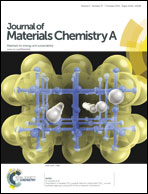Organic linker geometry controlled synthesis of coordination polymer spheres and their thermal transformation to yolk–shell metal oxides†
Abstract
Precise control over size, morphology and composition of coordination polymers (CPs) is challenging but important for using these hybrid materials for many more applications. Herein, we report a protocol of preparing unitary and multinary metal–carboxylic acid coordination polymers without additives. We found that the CPs morphology was controlled by the geometric angle (∠) of carboxylic groups in the organic linkers. At the ∠120°, the mono-dispersed and uniform spherical CPs were obtained with the central distribution size ranging from nanoscale to microscale, adjusted by the precursor concentration and reaction time. We also obtained a series of spherical metal-CPs, including transition and rare earth metals (Mg, Ni, Zn, In, Y, Sm, Eu, Gd, Er, Ho, Yb and Lu) and homogeneously distributed multinary metal-CPs. Moreover, the calcination of these CPs generated unitary and multinary metal oxides with yolk–shell structure. In addition, metal-CPs contain coordinatively unsaturated metal sites, which is confirmed by probe molecule adsorption-IR spectroscopy, and could catalyze the cyanosilylation of carbonyl substrates at 25 °C. Sixteen examples were tested and produced good to excellent yields over Eu-CPs.


 Please wait while we load your content...
Please wait while we load your content...